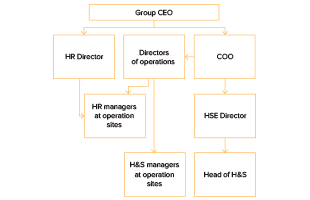At Solidcore, we believe that all work-related injuries and illnesses are preventable. Our top priority is ensuring the safe return after each working day of every person who works for and with Solidcore. Key to our health and safety strategy is effective leadership, fostering a zero-harm culture and rigorous risk management practices. We continually promote excellent safety behaviours to ensure all our people and contractors work in a safe environment. We invest heavily in safety training, and strive to meet the most stringent international health and safety standards.
Our health and safety targets are:
- Ensure zero fatalities and maintaining LTIFR at zero level among employees and contractors;
- Maintaining zero level of absent days following accidents;
- Digital technologies implementation aimed to improve safety on hazardous sites and roads;
- Safety culture advancement based on risk assessment and employee engagement;
- Ensuring that contracting organisations working on site implement hazard identification and safety risk assessment procedures
By embedding best practices in everything we do, we will continue to improve our safety performance.
Who is responsible

Each year, we identify and assess risks across the Group, create risk maps for all our working processes and locations, and then develop detailed programmes to reduce these risks. We carry out an annual qualitative hazardous risk assessment, and inform employees of the results through a range of communication channels. We adapted Critical Risks Management (CRM) system, which includes a health and safety action plan for all critical risks. For each risk, operation sites implement mitigation activities covering administration, risk elimination, engineering improvements, training and visualisation.
We follow a shift-by-shift risk assessment model to raise employee awareness of workplace dangers, manage risks promptly, and control the accuracy of our risk assessments. We apply this system most rigorously in hazardous operational areas, for example automobile transport, mines, and plant and power supply.
In
Find the latest safety performance data in our quarterly production press releases.
We go beyond what’s required by regulations to achieve the goals of zero fatalities and injuries. We have taken voluntary steps to implement best practices that encourage a culture of safety.
Training and engaging employees and contractors is essential to achieving our zero-harm goal. We provide training in occupational health, and industrial, electric and fire safety. Our employees and contractors attend refresher safety courses and some of those involved in dangerous works undergo mandatory safety training. To support the “zero harm” mindset, we hold contests and reward teams that achieve zero incident rate. Our safety communication campaign involves contests, articles in our company newspaper (including personal stories), checklists, videos and visual communications toolkits.
When selecting a contractor, we check their track record and refuse working with those which have low safety performance or high risks. We also require their safety management system to be comparable to that of Solidcore’s and make safety compliance a part of any contract.
In line with our commitment to Occupational Health and Safety, we want to ensure preparedness for all types of emergencies that may pose threat to the safety of people and the environment. We conduct emergency drills and test our response plans across all our hazardous facilities at least annually and at least monthly at the facilities with higher emergency risks.
All Solidcore’s emergency response plans are fully compliant with the applicable regulations. With the support of local authorities, Solidcore has created an action plan to practice emergency prevention at each of our hazardous facilities. We provide training for our in-house first responders and engage contractors for accident prevention and potential rescue work.
Solidcore’s emergency preparedness effort is underpinned by:
- Continuous improvement of the Occupational Health and Safety Management System implemented across all of our operations;
- Active licenses and permits required for certain types of safety-related measures;
- Safety inspections of all buildings, constructions and facilities associated with hazardous activities;
- Valid insurance policy for liability coverage in case of emergencies.
To identify emergency risks and their potential harm to the environment, we:
- Put together a comprehensive list of possible emergencies;
- Ensure that our hazardous facilities are listed in the official register of the governmental body;
Develop emergency response procedures;
- Procure insurance for the hazardous facilities.
- We use the following data for our emergency preparedness planning:
- Information on global environmental disasters and their causes;
- Audit and inspection records, environmental impact reports, safety assurance documentation and on-site checks records;
- Statutory audit reports;
- Constantly updated environmental monitoring data.
